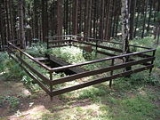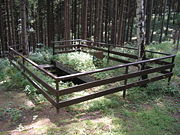
Zemlyanka
Encyclopedia
Zemlyanka — is an Eastern Slavic
name for a dugout
or earth-house which was used to provide shelter for humans or domestic animals. Based on a hole or depression dug into the ground, these structures are one of the most ancient types of housing known. Zemlyankas can be partially or fully recessed into the earth, with a flat roof covered with branches or sod
, or dug into a hillside. The use of natural earth for insulation and protection for underground living
has evolved into the "earth shelter" technology used today in architecture
.
 In World War II
In World War II
, partisan
s, or armed resistance fighters in Eastern Europe
sometimes lived in zemlyankas which were used as underground bunkers to provide shelter and a hiding place from enemies. Notably they were used by members of the famous "Bielski partisans
" in modern day Belarus. In Poland
they were called ziemianki.
song
written by A. Surkov-Listov in 1941 during the Battle of Moscow
. The use of zemlyankas by soldiers is mentioned in the song. However, due to its pessimism, the song was considered to be unpatriotic by the Soviet government at the time.
East Slavic languages
The East Slavic languages constitute one of three regional subgroups of Slavic languages, currently spoken in Eastern Europe. It is the group with the largest numbers of speakers, far out-numbering the Western and Southern Slavic groups. Current East Slavic languages are Belarusian, Russian,...
name for a dugout
Dugout (shelter)
A dugout or dug-out, also known as a pithouse, pit-house, earth lodge, mud hut, is a shelter for humans or domesticated animals and livestock based on a hole or depression dug into the ground. These structures are one of the most ancient types of human housing known to archeologists...
or earth-house which was used to provide shelter for humans or domestic animals. Based on a hole or depression dug into the ground, these structures are one of the most ancient types of housing known. Zemlyankas can be partially or fully recessed into the earth, with a flat roof covered with branches or sod
Sod
Sod or turf is grass and the part of the soil beneath it held together by the roots, or a piece of thin material.The term sod may be used to mean turf grown and cut specifically for the establishment of lawns...
, or dug into a hillside. The use of natural earth for insulation and protection for underground living
Underground living
Underground living refers simply to living below the ground's surface, whether in naturally occurring caves or in built structures.Underground homes are an attractive alternative to traditionally built homes for some house seekers, especially those who are looking to minimize their home's negative...
has evolved into the "earth shelter" technology used today in architecture
Architecture
Architecture is both the process and product of planning, designing and construction. Architectural works, in the material form of buildings, are often perceived as cultural and political symbols and as works of art...
.
World War II

World War II
World War II, or the Second World War , was a global conflict lasting from 1939 to 1945, involving most of the world's nations—including all of the great powers—eventually forming two opposing military alliances: the Allies and the Axis...
, partisan
Partisan (military)
A partisan is a member of an irregular military force formed to oppose control of an area by a foreign power or by an army of occupation by some kind of insurgent activity...
s, or armed resistance fighters in Eastern Europe
Eastern Europe
Eastern Europe is the eastern part of Europe. The term has widely disparate geopolitical, geographical, cultural and socioeconomic readings, which makes it highly context-dependent and even volatile, and there are "almost as many definitions of Eastern Europe as there are scholars of the region"...
sometimes lived in zemlyankas which were used as underground bunkers to provide shelter and a hiding place from enemies. Notably they were used by members of the famous "Bielski partisans
Bielski partisans
The Bielski partisans were an organisation of Jewish partisans who rescued Jews from extermination and fought against the Nazi German occupiers and their collaborators in the vicinity of Nowogródek and Lida in German-occupied Poland...
" in modern day Belarus. In Poland
Poland
Poland , officially the Republic of Poland , is a country in Central Europe bordered by Germany to the west; the Czech Republic and Slovakia to the south; Ukraine, Belarus and Lithuania to the east; and the Baltic Sea and Kaliningrad Oblast, a Russian exclave, to the north...
they were called ziemianki.
In popular culture
Zemlyanka was the name of an Eastern Front (World War II)Eastern Front (World War II)
The Eastern Front of World War II was a theatre of World War II between the European Axis powers and co-belligerent Finland against the Soviet Union, Poland, and some other Allies which encompassed Northern, Southern and Eastern Europe from 22 June 1941 to 9 May 1945...
song
Song
In music, a song is a composition for voice or voices, performed by singing.A song may be accompanied by musical instruments, or it may be unaccompanied, as in the case of a cappella songs...
written by A. Surkov-Listov in 1941 during the Battle of Moscow
Battle of Moscow
The Battle of Moscow is the name given by Soviet historians to two periods of strategically significant fighting on a sector of the Eastern Front during World War II. It took place between October 1941 and January 1942. The Soviet defensive effort frustrated Hitler's attack on Moscow, capital of...
. The use of zemlyankas by soldiers is mentioned in the song. However, due to its pessimism, the song was considered to be unpatriotic by the Soviet government at the time.

